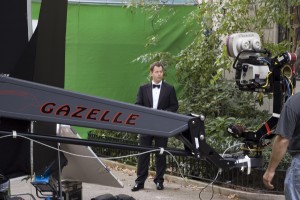In the comedy Ghost Town, Rhinofx provided visual effects, but two effects in particular made us curious here at fxguide: a non motion control timelapse helicopter shot and the principle ghost passing through effect. We figured it would be interesting to find out how these two special visual effects were achieved, so we spoke to the team at Rhinofx.
Timelaspe
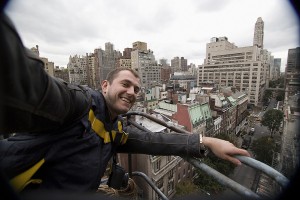
Normally, if one wants to see a tracking timelaspe photography clip, you need motion control, but RhinoFX solved the problem with Photogrametry and camera projection in Flame.
Using an EOS Canon Mk1D and a Nikon, controlled by standard Nikon camera software on top of buildings in NY, the team shot a sequence of stills and then took these sequences into Flame and camera-projected the clip over similar Geometry. There were several sequences shot, and one of the shoots occurred on a particularly cold and stormy night.
This posed quite a few issues. The team did have multiple redundant camera rigs, which was lucky as the harsh conditions caused one of the rig’s controlling laptop computers to fail. Also these conditions meant that odd frames would be lost as they would have just recorded large snow/rain drops close to the lens, blocking everything else out.
Each shot was 6 – 8 seconds long and the frames were timed to be triggered every minute. In one case the first shoot took two nights and then the team had to return to the exact same spot 21 days later and film a second half to show the passing of the seasons due to the changes in the trees’ foliage. Lining up the cameras and matching the exact angles required very precise alignments.
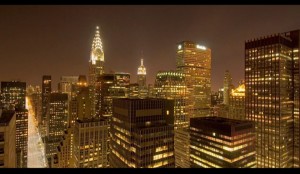
Once in Flame the images were handled as two separate layers so that the sky could be manipulated separately. As if the tracking shot was not difficult enough, in the second shot the camera needed to move more like a helicopter. To achieve this, 3D trees were built so that the closest trees could be seen to change perspective. This was then seamlessly blended with the more distant, real trees.
For each clip the raw files were brought in via a batch photoshop import, this batch process converted the files to a Cineon style LOG DPX file format. This allowed Flame to load standard 4K DPX files for a standard LOG 2K Cineon file export for the final film. The team experimented with simply working 2K but the projection process into a 3D space marginally softened the final output, and to avoid this they moved to a 4K input pipeline.
movielink(08Oct/ghost/timelapse_1.mov, Click here to see the tracking timelaspe MOV)
movielink(08Oct/ghost/timelapse_2.mov, Click here to see the Central Park timelapse MOV)
Originally the shots were not quoted as moving motion control shots, but the team really wanted to try and produce something more interesting. As real motion control was cost prohibitive, the team decided that movement would really add dimension, and so they came up with the approach. But even with camera mapping, the effect of timelapse can still look very much like stock footage.
To address this even further Arman Matin, Visual Effects supervisor, decided to do a complex blending of the original frames. This complex time-based blending of forward and past frames gives the footage a softer slightly more ethereal feel. “I used Fusion and After Effects motion estimation techniques on 5 frames forward and 2 frames backwards,.. once you do that eveything blends,” commented Matin. “You can imagine NY at dusk with hundreds of lights turning on could look very jittery.”
Fred Murphy, the Director of Photography, contributed on shot design and composition but the location survey and the actual timelapse shoots were done by RhinoFX’s second unit. The team flew in Yaron Eini, a vfx still photographer from Israel, to do the second unit photography. Arman Matin had shot with Eini before and felt confident he could produce the cinematic drama the shots called for.
The shoot went for 4 days. One of the locations was extremely cold – and even though there was power for the laptops, Yaron Eini had to stay up all night – checking the cameras every 15 minutes. From this extremely barren rooftop location, the team moved to the splendor and luxury of an apartment in Trump Towers, a much warmer location – which was the base for the ‘helicopter’ Central Park shot.
One of the issues to be solved in editorial was the split from when the sun set, in other words how much daylight vs nighttime was to be included in the shot. To give the editorial department something to cut, the cameras were set up to shoot JPEG and RAW. The JPEGs could then be immediately loaded into Quicktime as an image sequence and exported for editorial.
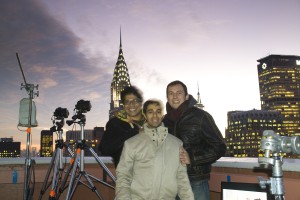
Ghost effect
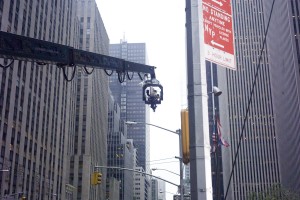
An important gag in the film is a ghost being walked through by the characters in the film who are still alive. While it is not a complex job to do a simple wipe, the team aimed to make the effect more visceral. To aid in this the standard A B foreground plates were photographed sometimes against greenscreen, but then in post 3D models were built of the actor and the spaces they occupied. In 3D, the two models move through each other giving the compositor a very accurate guide as to the intersecting surfaces.
Not only is this guide able to produce more accurate 3 dimensional relationships, but it allows for shadow passes to be created. In real life as the actors are never in the same space, they cast no shadows onto each other, but in 3D a shadow map and the way it falls over the complex moving second actor can easily be derived. This shadow pass is rendered on null ‘invisible’ people models and then they can be exported and used as part of the comp. This removes the guess work and allows the two actors to affect each others’ light.
To further aid the effect, a small particle wake was created that indicates some ghost drag effect from the living to the dead. This affects the trailing edge of the actors being composited. Roto and detailed compositing is still needed in Flame but the overall effect adds to the production value of an otherwise ‘odd’ gag.
movielink(08Oct/ghost/Pinkus_Frank.mov, Click here to see the first pass through ghost effect)
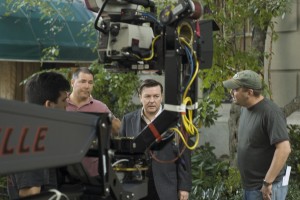
movielink(08Oct/ghost/COP.mov, Click here to see the clip from the film)
movielink(08Oct/ghost/COP_assembly.mov, Part 2 Click here to see the making of clip with the various 3D guides)
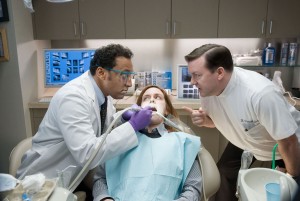
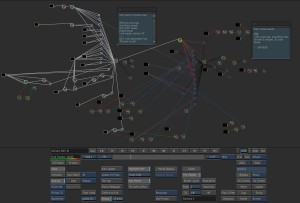
Team credits
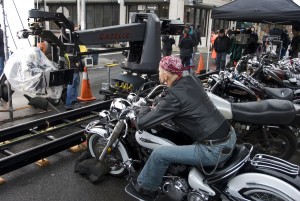
Sequence Credits:
Arman Matin – Visual effects supervisor
Jim Rider – Compositing supervisor/plate supervisor
Camille Geier – Exec. Producer
Cara Buckley – producer
Karin Levinson – Production Executive
Bogdan Mihajlovic – Lead TD/Plate supervisor
Dave Reynolds – Flame Compositor
Ronen Sharabani – Flame compositor
Yoshiko Hirati – Flame Compositor
Brad Scott – Flame Compositor
Jasmine Katatikarn – Lighting TD
Ivan Guerrero – Dynamics TD
Sean Curran – Animator
Goran Ognjanovic – Animator
Chris Hill – Match move
Piotr Glabinski – Modeler
Bora Jurisic – 3D matte painter
Yaron Eini – vfx still photographer
Paul Tsung – Head of IT
Barry Furlano – Flame Assistant
Gerta Xhelo – Production Coordinator
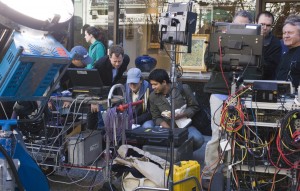
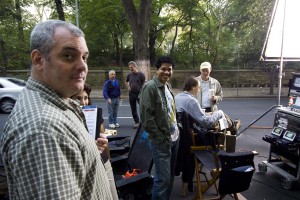
He sees dead people … and they annoy him

